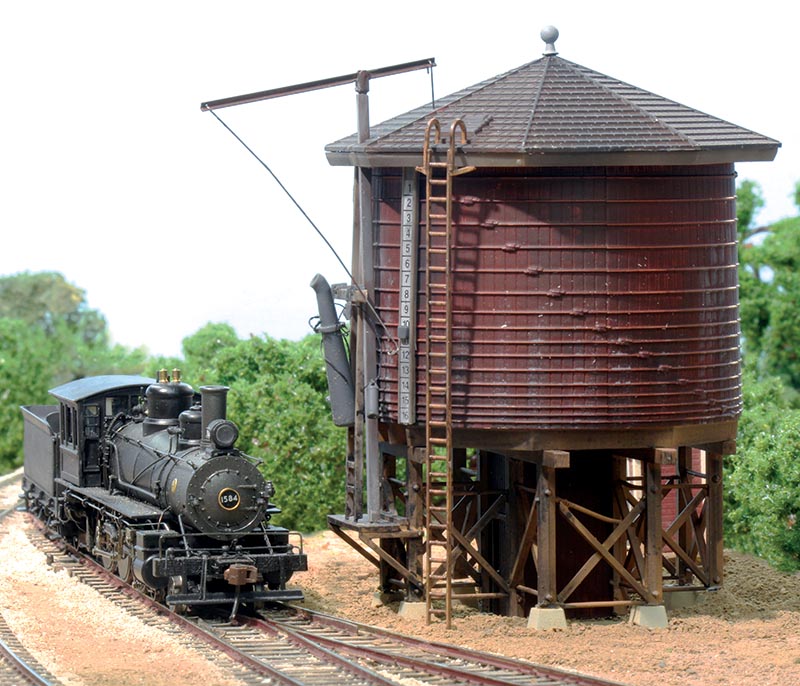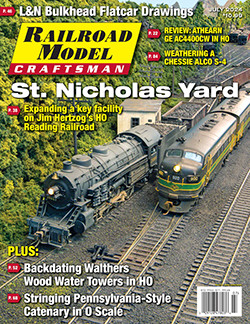 by Robert Schleicher/photos by the author except as noted
by Robert Schleicher/photos by the author except as noted
The Walthers Cornerstone HO wood water tank (no. 933-3531) is a replica of one of most common 50,000-gallon wood tanks built in the early 1900s. The earlier 50,000-gallon water tanks (built in the late 1880s and early 1900s) were mounted on much lower wood support trusses. A nearly identical design was also common on most of the Colorado three-foot narrow gauge railroads. The Walthers tank can be converted into the earlier style by shortening the lower wood trusses. The prototype for the Walthers model was a tank that had the linkage to open the water valve inside the tank. Some of the earlier tanks had an external lever to open the water valve rather than an internal link. The tall pole that supported the horizontal lever arm that formed the linkage to open the flap valve is very visible and it is easy enough to recreate for either an HO or HOn3 version. In N scale, the Tichy Train Group no. 2600 plastic kit is nearly identical to the Walthers HO models.
There were no standards for railroad water towers; however, most were relatively simple structures built by the railroad’s workshop to what became, by application, a common design. The 50,000-gallon tank was probably the most popular size across America. The 1893 book Buildings and Structues of American Railroads describes them: “Wooden tanks are generally built circular in shape, and the staves and sundry parts are turned out to a large extent by machinery and kept in stock, so that repairs and renewals can be made very cheaply and quickly.
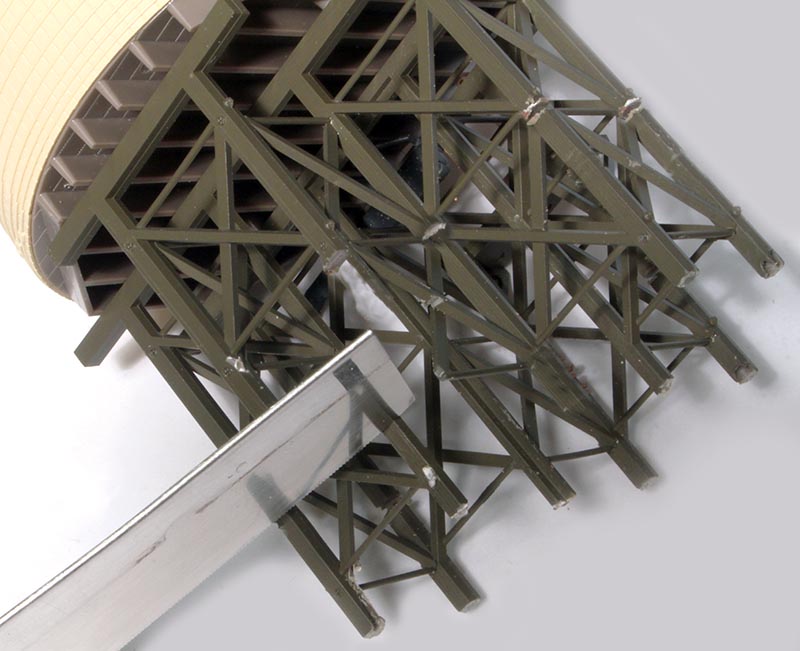
In addition to these features, and the cheapness of the first cost, wooden tubs afford, when roofed over, in themselves a certain protection against cold, which could not be obtained in an iron tank construction without a special building or lining around it. Circular tanks are made of 14-, 15-, or 16-ft. staves, and the diameters most generally in use are 16, 18, 20, 22, 24, and 30 ft. According to the selected combination of height and depth, the capacities vary from about 20,000 gallons to 80,000 gallons.
The floor of a tank is usually set about 12 to 15 feet above the track, unless a high-pressure service for other purposes is desired besides the delivery of water to engines. The foundations are usually wooden trusses-bents on mud-sills or on small stone foundation-walls.
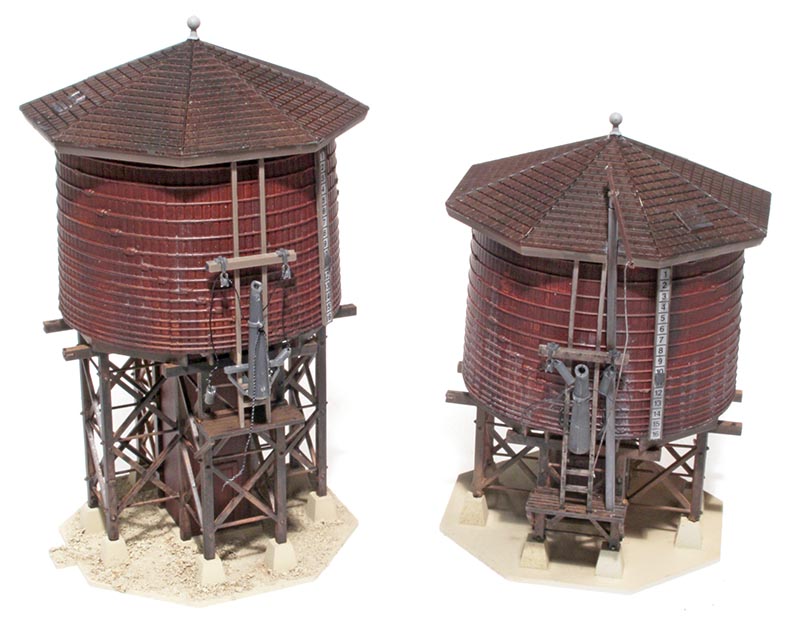
The discharge or delivery pipe connects with a goose-neck spout attachment at the face of the tank, or with a stand-pipe located at some distance from the tank. An indicator or marker on a graduated staff is also universally in use to indicate the height of the water in the tank, and it is generally so arranged as to be readily seen from approaching trains.”
The Walthers water tank kit positions the water tank about 24 ft. above rails, which was common practice in the teens and later. The majority of the wood water tanks on the Colorado narrow gauge lines were built in the early 1900s and most had 50,000-gallon tanks suspended about 12 feet above the rails.
Railroad water tanks had delivery spouts that were lowered directly over the open hatch in the top of the tender. The delivery spouts were hinged at the bottom and suspended by a rope or cable that ran through an elevated pulley to a counterweight, so the relatively heavy spout could be lowered or raised accurately with just arm pressure from the fireman. A flap valve was installed on the floor inside the tank to turn the water on or off. The system was almost identical to that which operates the flush toilet in your bathroom. There was a lot of water weight pressing down on that flap valve so the operating pulleys or levers were needed to make it possible for the fireman to open the water valve. The water pressure in the tank closed the valve automatically. There was usually no adjustment for the rate of the water flow, so the skill needed was to dump as much water as possible in the shortest amount of time — it was just water, so some overfill was expected — the skillful fireman could judge just when to pull the rope to shut off the flow with the tender’s tank full to the brim. The levers and pulleys that were used to actuate the water flap valve were usually positioned inside the tank so they were not visible.
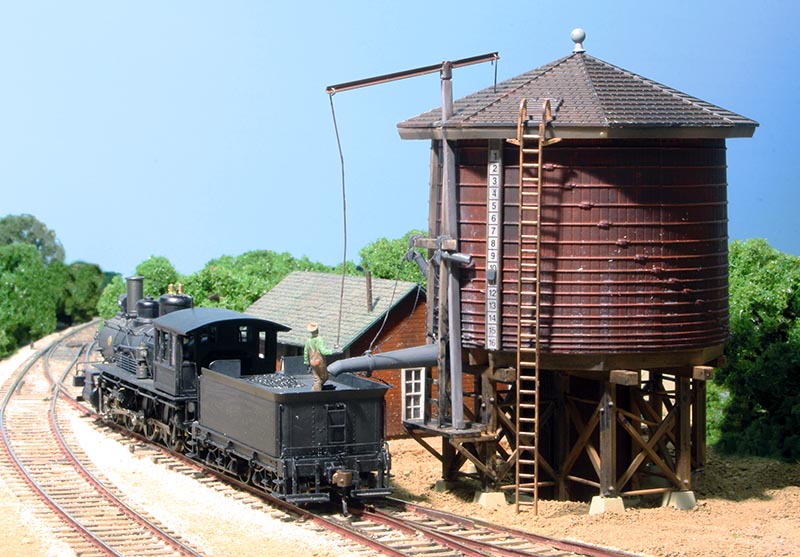
However, some earlier water tanks and many of the Colorado narrow gauge railroad water tanks had an external leverage system with a tall vertical pole supporting a horizontal bar. This T-shaped device is the most distinctive feature of many of these early water tanks. The flap valve was opened by a cable or rope connected to one end of the horizontal bar. A second rope at the opposite end of the bar was positioned so the fireman could reach the end of the rope from the top of the tender or from a platform on the side of the water tank.
This typical 50,000-gallon water tank design has been the subject of dozens of kits for many decades. Skyline had similar cardstock kits in the 1940s in HO scale, Alexander Models had a wood craftsman kit in HO, Atlas introduced their plastic HO kit in the 1960s, and Model Structures had O scale wood craftsman kits to recreate a similar design found on Southern Pacific. Today, Walthers offers this 50,000-gallon tank as a plastic kit or built-up, American Model Builders’ wood craftsman kit (no. 154) includes the option of the external T-shaped valve mechanism like that on these pages. Durango Press has offered HO water tanks as plastic kits with the lower tank as replicas of the Rio Grande Southern Trout Lake tank and a typical Denver & Rio Grande Western narrow gauge water tank…


